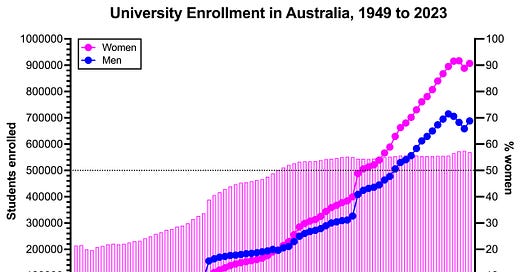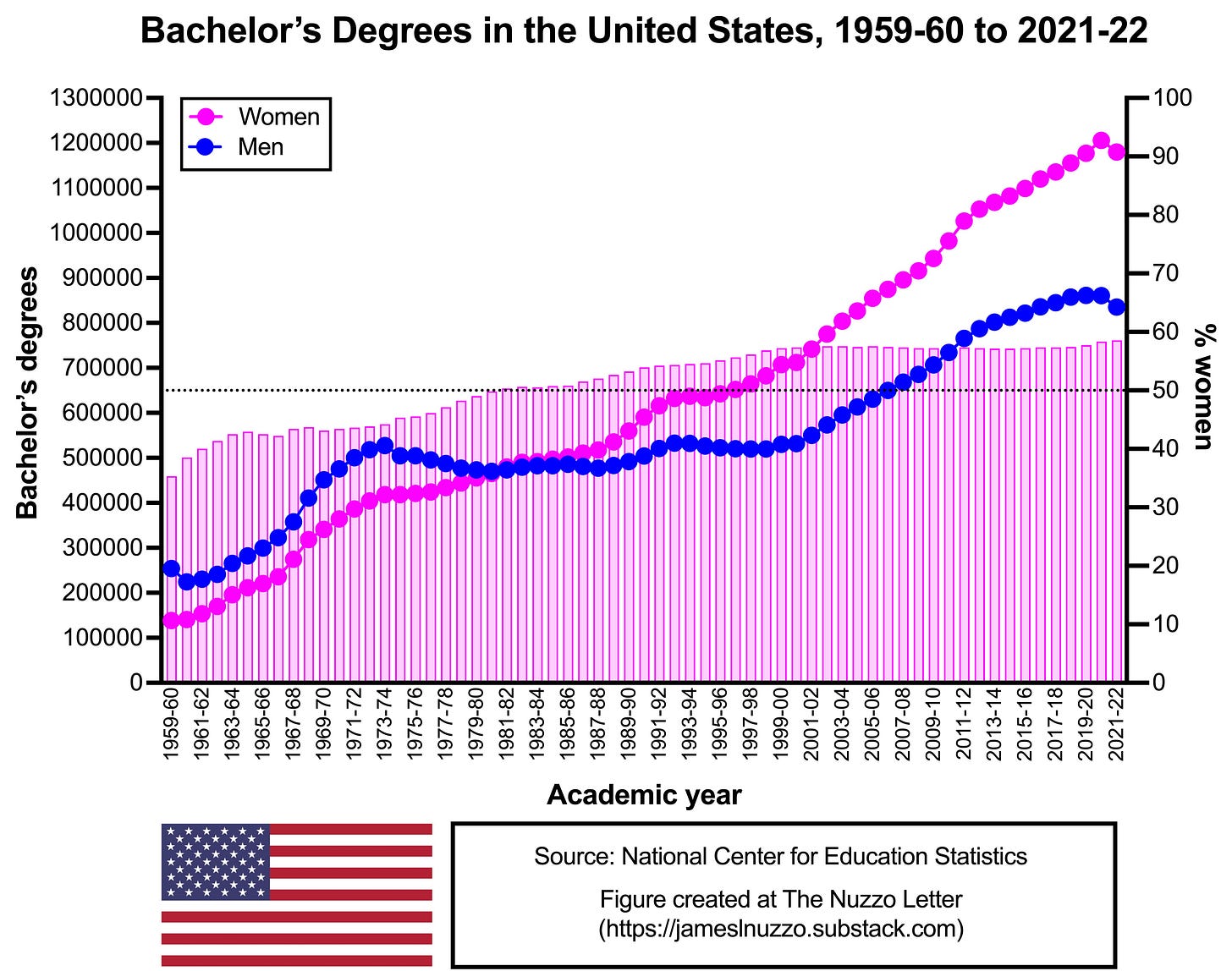This week’s graphs show sex-segregated data on university enrollments and degrees earned in Australia, Canada, and the United States (U.S.).
AUSTRALIA
The first graph shows the number of men and women enrolled at universities annually in Australia from 1949 to 2023. Up until the COVID-19 pandemic, numbers of men and women enrolled increased most years. However, the pandemic caused enrollments to drop. As of 2023, they have not fully recovered. The first year that female enrollment exceeded male enrollment was 1987 (50.1% female enrollment). Female enrollment has exceeded male enrollment in all subsequent years; it peaked in 2022 (57.4%); and it currently stands at 56.9% (2023).
The second graph shows the number of university degrees (all types) completed by male and female students in Australia annually between 1995 and 2023. Every year, more women than men completed university degrees. In 2023, women earned 58.8% of all university degrees in Australia.
CANADA
This graph shows the number of bachelor’s degrees earned annually by men and women at universities in Canada between 1992 and 2022. A significantly higher proportion of women than men completed bachelor’s degrees each year over this 31-year period. In 1992, 57.3% of bachelor’s degrees in Canada were earned by women. This number peaked in 2007 (62.2%) and was 60.1% in 2022 (the last year data were available).
UNITED STATES
This graph shows the number of bachelor’s degrees earned annually by men and women in the U.S. from the 1959-60 to 2022-22 academic school years. The first academic year that women earned more bachelor’s degrees than men was 1981-82 (50.3% women). In all subsequent years, the number of women earning bachelor’s degrees outnumbered the number of men earning bachelor’s degrees. This difference peaked in 2021-22, with women making up 58.5% of bachelor’s degree earners.
Bonus Commentary
More women than men have been earning university degrees in Australia, Canada, and the U.S. for many years. The shift to more female than male degree earners occurred in the late 1980s and early 1990s. Today, women make up 58%-60% of bachelor’s degree earners in these three countries.
Numerous factors contribute to fewer males than female enrolling in universities and completing bachelor’s degrees. Some examples include: more males than females are in prison, males have lower high school grade point averages than females, males have higher high school dropout rates than females, males have poorer reading and writing skills than females, males have less access to financial aid and scholarships than females, and fewer initiatives exist for increasing male enrollments. Regarding this last factor, attempts at increasing female, but not male, enrollment are still occurring. Curtin University and the University of Western Australia both recently advertised Project Officer roles in which the main responsibility of the Officer is to increase the number of female STEM students via high school recruitment strategies. No similar jobs were posted for increasing the number of male students in any field. Thus, to the extent that such Project Officers are successful at increasing the number of female STEM students, universities will exacerbate the current sex difference in university enrollments.
Related Content at The Nuzzo Letter
SUPPORT THE NUZZO LETTER
If you appreciated this content, please consider supporting The Nuzzo Letter with a one-time or recurring donation. Your support is greatly appreciated. It helps me to continue to work on independent research projects and fight for my evidence-based discourse. To donate, click the DonorBox logo. In two simple steps, you can donate using ApplePay, PayPal, or another service. Thank you!












Thanks for these. So about 1987 we reached the point where both men and women were getting an equal number of degrees. If feminism was about equality it should have stopped right there. But nooooooo. It's not about equality, its about advantage and control. More stuff for women, punish those selfish men.
Clearly women need more funding and more special "women in STEM" programs. We cannot allow this disparity to continue. Think about your daughters here. Women are so oppressed